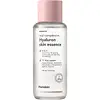What's inside
What's inside
 Key Ingredients
Key Ingredients

 Benefits
Benefits

 Ingredients Side-by-side
Ingredients Side-by-side

Water
Skin ConditioningPropanediol
SolventGlycerin
HumectantBetaine
HumectantPanthenol
Skin Conditioning1,2-Hexanediol
Skin ConditioningPolyglycerin-3
HumectantEthylhexylglycerin
Skin ConditioningDisodium EDTA
Carbomer
Emulsion StabilisingMadecassoside
AntioxidantButylene Glycol
HumectantScutellaria Baicalensis Root Extract
AstringentTocopherol
AntioxidantCamellia Sinensis Leaf Extract
AntimicrobialWater
Skin ConditioningGlycerin
HumectantButylene Glycol
HumectantPentylene Glycol
Skin ConditioningLinum Usitatissimum Seed Extract
PerfumingHydrolyzed Collagen
EmollientRhus Semialata Extract
Skin ConditioningGynostemma Pentaphyllum Leaf/Stem Extract
AntioxidantZostera Marina Extract
Skin ConditioningCeramide AP
Skin Conditioning1,2-Hexanediol
Skin ConditioningSodium Hyaluronate
HumectantHydroxyethylcellulose
Emulsion StabilisingCitric Acid
BufferingSodium Citrate
BufferingHydrolyzed Hyaluronic Acid
HumectantSaccharide Isomerate
HumectantHydrolyzed Algin
Disodium EDTA
Phenoxyethanol
PreservativeWater, Glycerin, Butylene Glycol, Pentylene Glycol, Linum Usitatissimum Seed Extract, Hydrolyzed Collagen, Rhus Semialata Extract, Gynostemma Pentaphyllum Leaf/Stem Extract, Zostera Marina Extract, Ceramide AP, 1,2-Hexanediol, Sodium Hyaluronate, Hydroxyethylcellulose, Citric Acid, Sodium Citrate, Hydrolyzed Hyaluronic Acid, Saccharide Isomerate, Hydrolyzed Algin, Disodium EDTA, Phenoxyethanol
 Reviews
Reviews

Ingredients Explained
These ingredients are found in both products.
Ingredients higher up in an ingredient list are typically present in a larger amount.
1,2-Hexanediol is a synthetic liquid and another multi-functional powerhouse.
It is a:
- Humectant, drawing moisture into the skin
- Emollient, helping to soften skin
- Solvent, dispersing and stabilizing formulas
- Preservative booster, enhancing the antimicrobial activity of other preservatives
Butylene Glycol (or BG) is used within cosmetic products for a few different reasons:
Overall, Butylene Glycol is a safe and well-rounded ingredient that works well with other ingredients.
Though this ingredient works well with most skin types, some people with sensitive skin may experience a reaction such as allergic rashes, closed comedones, or itchiness.
Learn more about Butylene GlycolDisodium EDTA plays a role in making products more stable by aiding other preservatives.
It is a chelating agent, meaning it neutralizes metal ions that may be found in a product.
Disodium EDTA is a salt of edetic acid and is found to be safe in cosmetic ingredients.
Learn more about Disodium EDTAGlycerin is already naturally found in your skin. It helps moisturize and protect your skin.
A study from 2016 found glycerin to be more effective as a humectant than AHAs and hyaluronic acid.
As a humectant, it helps the skin stay hydrated by pulling moisture to your skin. The low molecular weight of glycerin allows it to pull moisture into the deeper layers of your skin.
Hydrated skin improves your skin barrier; Your skin barrier helps protect against irritants and bacteria.
Glycerin has also been found to have antimicrobial and antiviral properties. Due to these properties, glycerin is often used in wound and burn treatments.
In cosmetics, glycerin is usually derived from plants such as soybean or palm. However, it can also be sourced from animals, such as tallow or animal fat.
This ingredient is organic, colorless, odorless, and non-toxic.
Glycerin is the name for this ingredient in American English. British English uses Glycerol/Glycerine.
Learn more about GlycerinWater. It's the most common cosmetic ingredient of all. You'll usually see it at the top of ingredient lists, meaning that it makes up the largest part of the product.
So why is it so popular? Water most often acts as a solvent - this means that it helps dissolve other ingredients into the formulation.
You'll also recognize water as that liquid we all need to stay alive. If you see this, drink a glass of water. Stay hydrated!
Learn more about Water